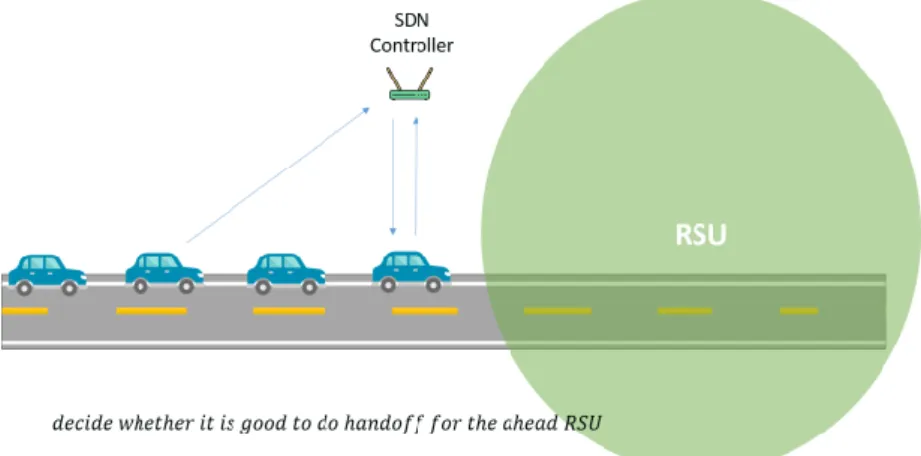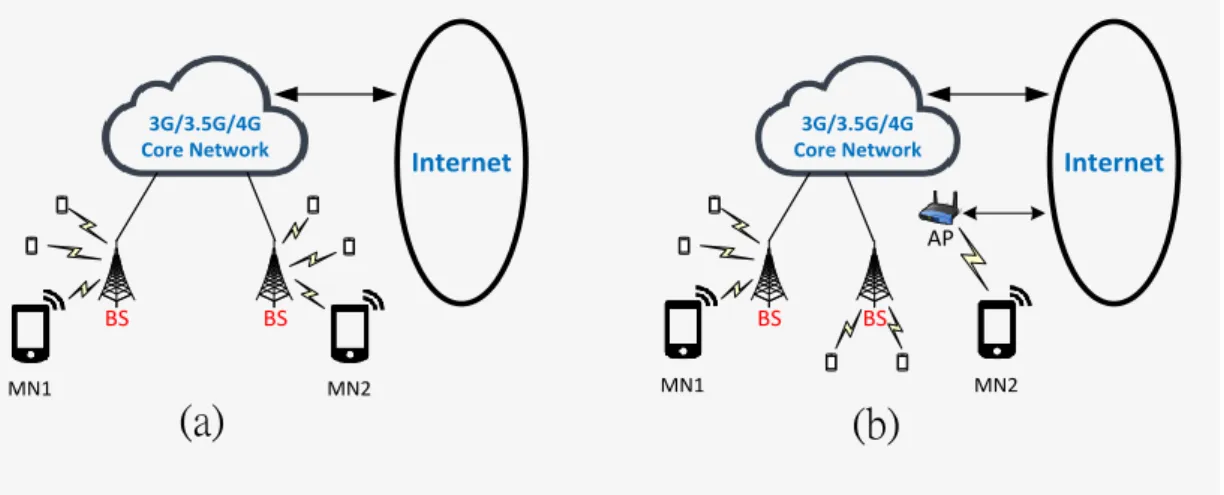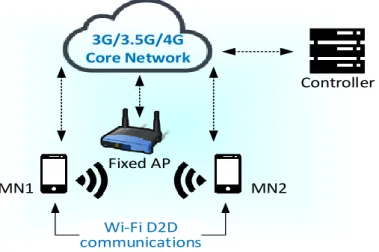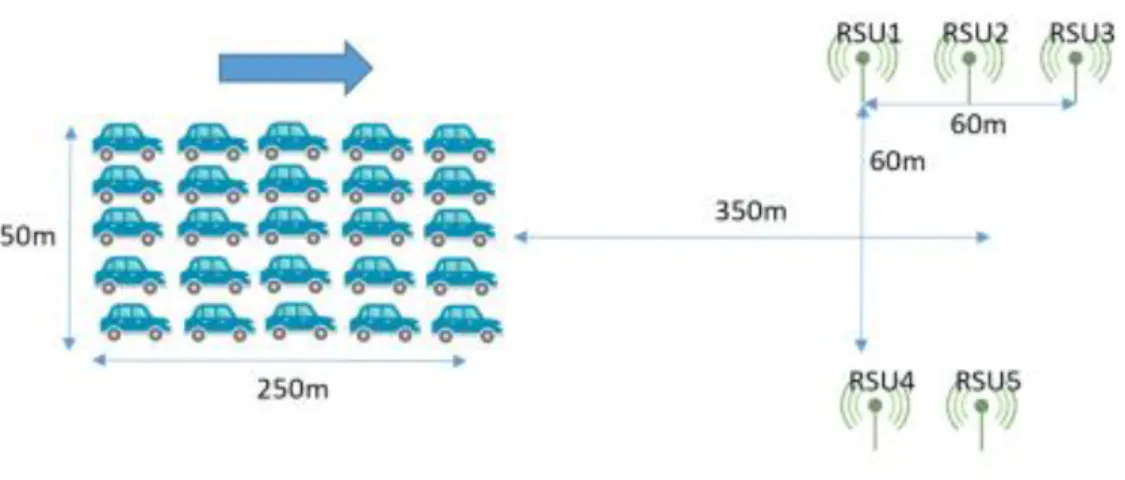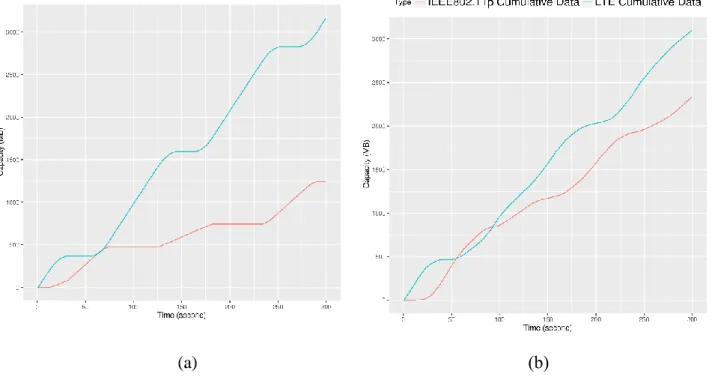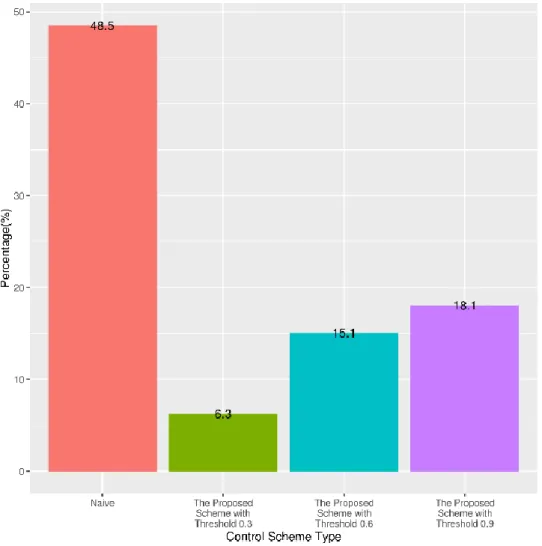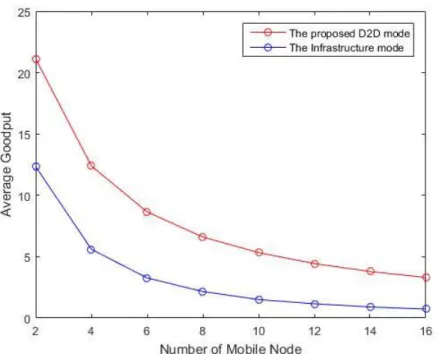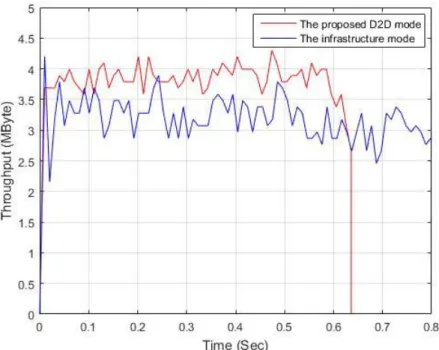科技部補助專題研究計畫成果報告
期末報告
應用軟體定義網路的D2D/V2V/I2V通訊之行動管理與資料傳送
計 畫 類 別 : 個別型計畫 計 畫 編 號 : MOST 105-2221-E-006-063-執 行 期 間 : 105年08月01日至106年07月31日 執 行 單 位 : 國立成功大學資訊工程學系(所) 計 畫 主 持 人 : 黃崇明 共 同 主 持 人 : 江孟書、程榮祥 報 告 附 件 : 出席國際學術會議心得報告中 華 民 國 106 年 09 月 03 日
中 文 摘 要 : 基於隨處皆可連上網際網路的情境之中,將3G/3.5G/4G行動網路的 資料流量分流到Wi Fi上是很常使用的技巧,假設3G/3.5G/4G行動網 路的訊號覆蓋範圍與Wi Fi有所重疊的環境之下,節點可從
3G/3.5G/4G行動網路切換到Wi Fi網路。Wi Fi網路分流一般可分為 兩種,一種是基於infrastructure-based的分流,一種是基於ad hoc -based的分流。而在我們的計畫之中,亦為這兩種網路提供解 決網路雍塞的控制方法。在infrastructure-based的分流方面,是 設計在車載網路之上,讓平常用3G/3.5G/4G行動網路到Internet server上擷取資料的車子,在進入IEEE 802.11p的 Road Side Unit (RSU)的訊號範圍時,換手到RSU,提供3G/3.5G/4G行動網路中之車 載網路分流;而以ad hoc-based的分流則是針對在3G/3.5G/4G行動 網路的一般行動裝置,透過裝置與裝置之間之Device-to- Device (D2D)網路進行分流。此計畫以Software Defined Network(SDN)架 構為基礎,解決上述二個研究議題。SDN的架構帶來網路方便管理的 優勢。在SDN控制器的精準控制之下,移動節點得以跟遠端的溝通節 點建立更順暢的連線,SDN 架構主要帶來的優勢有(1) 更方便發佈 控制策略的網路架構 (2) 和分散式的網路架構相比更快速的換手機 制。 中 文 關 鍵 詞 : 行動性管理協定、換手、行動使用者、軟體控制網路。
英 文 摘 要 : Traffic offloading from 3G/3.5G/4G cellular network to Wi Fi network is commonly used for reducing the traffic in 3G/3.5G/4G cellular network to achieve the ubiquitous communication scenario. Let the signal coverage of a Wi Fi AP be overlapped/inside the signal coverage of the
3G/3.5G/4G cellular network. A mobile node can switch its connection from a BS of 3G/3.5G/4G cellular network to the AP of Wi Fi network when the mobile node is moved into the Wi Fi AP's signal coverage. Two types of current Wi Fi offloading are (1) infrastructure-based and (2) the other is ad hoc-based. This project has designed two kinds of network control schemes for the aforementioned two types of offloading. The infrastructure-based offloading
concentrates on vehicular network, which is called
Vehicular-to-Infrastructure based architecture. The ad hoc-based offloading concentrates on the offloading for regular mobile devices in 3G/3.5G/4G cellular network, which is based on the device-to-device (D2D) communication paradigm. This project adopts Software Defined Network (SDN) for resolving the aforementioned two problems. The SDN
technology brings the advantage of convenience of network management. With the accurate network resource management done by SDN Controller, the mobile nodes are able to
communicate the corresponding peers smoothly. The benefits of SDN architecture, (1) elastic architecture about
deployment of the control scheme, (2) faster handover time compared with distributed control scheme.
英 文 關 鍵 詞 : Wi Fi Offloading, Fast Handover, Media Independent Handover, Software-defined network.
行政院國家科學委員會補助專題研究計畫成果報告
(□期中進度報告/
期末報告)
應用軟體定義網路的
D2D/V2V/I2V 通訊之行動管理與資料傳送
計畫類別:■個別型計畫 □整合型計畫
計畫編號:MOST 105-2221-E-006-063 -
執行期間:2016 年 08 月 01 日至 2017 年 07 月 31 日
執行機構及系所:國立成功大學資訊工程系
計畫主持人:黃崇明
共同主持人:江孟書/程榮祥
計畫參與人員:陶維俊、蘇偉隆、陳星翰、陳瑜棻、魏睿賢、吳宗祐、郭逸安和
劉哲宏
本計畫除繳交成果報告外,另含下列出國報告,共 _2_ 份:
□執行國際合作與移地研究心得報告
■出席國際學術會議心得報告
期末報告處理方式:
1. 公開方式:
□非列管計畫亦不具下列情形,立即公開查詢
■涉及專利或其他智慧財產權,□一年■二年後可公開查詢
2.「本研究」是否已有嚴重損及公共利益之發現:■否 □是
3.「本報告」是否建議提供政府單位施政參考 □否 ■是,工研院及資策會
(請列舉提供之單位;本會不經審議,依勾選逕予轉送)
中 華 民 國 106 年 08 月 10 日
目錄
目錄 ... I 圖目錄 ... II 表目錄 ... 錯誤! 尚未定義書籤。 摘要 ... III 1. 前言 ... 1 2. 研究目的 ... 4 3. 文獻探討 ... 5 4. 研究方法 ... 5 5. 研究成果與討論 ... 7 6. 出版情況 ... 13 7. 結論 ... 13 8. 參考文獻 ... 13圖目錄
Figure 1. The abstract architecture of the proposed SDN-based vehicular network ... 2
Figure 2. The configuration for the proposed SDN-based V2I offloading ... 2
Figure 3. The communication configurations of using (a) 3G/3.5G/4G cellular network and (b) the Wi Fi offloading. ... 3
Figure 4. The communication configurations of using (a) the Wi Fi infrastructure-based Wi Fi offloading and (b) the D2D-based Wi Fi offloading. ... 3
Figure 5. The abstract configuration of our proposed SDN-based wireless mobile networks for Wi Fi infrastructure-based and D2D-based offloading. ... 6
Figure 6. The position allocation scenario. ... 7
Figure 7. Comparison of the average throughput of the naïve scheme and the proposed control scheme with threshold 0.3, 0.6, and 0.9 using the 1Mbps sending rate ... 8
Figure 8. Cumulative data of using RSUs, (a) the naïve scheme using the 1Mbps sending rate (b) the proposed control scheme with threshold 0.3 using the 1Mbps sending rate ... 9
Figure 9. Average packet loss rate of IEEE 802.11p network packet loss rate using 1Mbps sending rate ... 10
Figure 10. The comparison of the average goodput in the AP of both modes. ... 11
Figure 11. The comparison of the variety of the throughput during the transmission period. ... 12
摘要
中文摘要:
基於隨處皆可連上網際網路的情境之中,將3G/3.5G/4G 行動網路的資料流量分流到 Wi Fi 上是很常使用的技巧,假設 3G/3.5G/4G 行動網路的訊號覆蓋範圍與 Wi Fi 有所重疊的環境 之下,節點可從3G/3.5G/4G 行動網路切換到 Wi Fi 網路。Wi Fi 網路分流一般可分為兩種,一 種是基於infrastructure-based 的分流,一種是基於 ad hoc -based 的分流。而在我們的計畫之 中,亦為這兩種網路提供解決網路雍塞的控制方法。在infrastructure-based 的分流方面,是設 計在車載網路之上,讓平常用3G/3.5G/4G 行動網路到 Internet server 上擷取資料的車子,在 進入IEEE 802.11p 的 Road Side Unit (RSU)的訊號範圍時,換手到 RSU,提供 3G/3.5G/4G 行 動網路中之車載網路分流;而以ad hoc-based 的分流則是針對在 3G/3.5G/4G 行動網路的一般 行動裝置,透過裝置與裝置之間之Device-to-Device (D2D)網路進行分流。此計畫以 Software Defined Network (SDN)架構為基礎,解決上述二個研究議題。SDN 的架構帶來網路方便管理 的優勢。在SDN 控制器的精準控制之下,移動節點得以跟遠端的溝通節點建立更順暢的連 線,SDN 架構主要帶來的優勢有(1) 更方便發佈控制策略的網路架構 (2) 和分散式的網路架 構相比更快速的換手機制
中文關鍵字:
行動性管理協定、換手、行動使用者、軟體控制網路。英文摘要:
Traffic offloading from 3G/3.5G/4G cellular network to Wi Fi network is commonly used for reducing the traffic in 3G/3.5G/4G cellular network to achieve the ubiquitous communication scenario. Let the signal coverage of a Wi Fi AP be overlapped/inside the signal coverage of the 3G/3.5G/4G cellular network. A mobile node can switch its connection from a BS of 3G/3.5G/4G cellular network to the AP of Wi Fi network when the mobile node is moved into the Wi Fi AP's signal coverage. Two types of current Wi Fi offloading are (1) infrastructure-based and (2) the other is ad hoc-based. This project has designed two kinds of network control schemes for the aforementioned two types of of-floading. The infrastructure-based offloading concentrates on vehicular network, which is called Ve-hicular-to-Infrastructure based architecture. The ad hoc-based offloading concentrates on the offload-ing for regular mobile devices in 3G/3.5G/4G cellular network, which is based on the device-to-device (d2D) communication paradigm. This project adopts Software Defined Network (SDN) for resolving the aforementioned two problems. The SDN technology brings the advantage of convenience of net-work management. With the accurate netnet-work resource management done by SDN Controller, the mo-bile nodes are able to communicate the corresponding peers smoothly. The benefits of SDN architec-ture, (1) elastic architecture about deployment of the control scheme, (2) faster handover time com-pared with distributed control scheme.
英文關鍵字:
Wi Fi Offloading, Fast Handover, Media Independent Handover, Soft-ware-defined network.1. 前言
The project contains two parts; one is for the Software-Defined Network (SDN) – based Vehicle to Infrastructure (V2I) offloading scheme from cellular network to 802.11p network and the other one is the Device-to-Device (D2D) Communication–based Wi-Fi offloading using the Software Defined Net-work (SDN) –enabled Wireless Mobile NetNet-work Environment.
For the first part, Vehicular Ad Hoc Network (VANET) is an emergent wireless mobile network [1][2]. In VANET, each vehicle is equipped with an On Board Unit (OBU) and the communication par-adigm can be Vehicle to Vehicle (V2V) or Vehicle to Infrastructure (V2I). This work tackles the problem of the offloading from 3G/3.5G/4G cellular network to IEEE 802.11p network for VANET. The scenario of IEEE 802.11p offloading in VANET that is considered in this work is as follows. Let the OBU of a vehicle X be equipped with a 3G/3.5G/4G cellular network interface and an IEEE 802.11p network interface. X regularly uses the 3G/3.5G/4G cellular network interface of its OBU for V2I (Vehicle to Infrastructure) communication. When X is in the IEEE 802.11p network signal coverage of a RSU, it can offload its V2I communication from the 3G/3.5G/4G cellular network to IEEE 802.11p network. That is, X’s V2I communication has the handoff from the 3G/3.5G/4G cellular network to the IEEE 802.11p network.
Main concerns that should be considered in VANETs offloading from the 3G/3.5G/4G cellular network to the IEEE 802.11p network of RSU are as follows: 1) Is RSU’s IEEE 802.11p networking situation good enough to allow vehicle X to have the offloading? Since the vehicle is moving, if the networking situation of RSUs 802.11p network is bad, it may need X to handoff back to 3G/3.5G/4G cellular network again after X handoff to RSU’s IEEE 802.11p network for a very short time period or even immediately. That is, it may take longer time overhead for the messaging of handoff processing because RSU’s IEEE 802.11p networking situation is bad and thus the effective time period for offload-ing data transmission through RSU’s IEEE 802.11p network becomes shorter. In the worst/extreme case, it may be out of the signal coverage of RSU’s IEEE 802.11p network before the handoff processing from 3G/3.5G/4G cellular network to RSU’s IEEE 802.11p network is done because the vehicle is moving such that the staying time period inside the signal coverage of the IEEE 802.11p network is limited! 2) Can the handoff decision be made before vehicle X senses the signal of the ahead IEEE 802.11p RSU? If the offloading can be decided before X enters into the signal coverage of the ahead IEEE 802.11p RSU, i) X can decide not to handoff from 3G/3.5G/4G cellular network to the ahead RSU’s IEEE 802.11p network if the networking situation of the ahead RSU’s IEEE 802.11p network is too bad even if the transmission expense is free and ii) X can save the handoff decision overhead such that X can keep in the 3G/3.5G/4G cellular network without wasting the handoff decision time spent inside RSU’s IEEE 802.11p network when the negative handoff decision is made: It takes some computing time overhead if the handoff decision is made after vehicle X entering into the signal coverage of the corresponding IEEE 802.11p RSU. Figure 1 depicts the abstract architecture of the proposed SDN-based vehicular network. Figure 2 depicts the configuration for the proposed SDN-based V2I offloading.
Figure 1 The abstract architecture of the proposed SDN-based vehicular network.
Figure 2. The configuration for the proposed SDN-based V2I offloading.
For the second part, with the advance of wireless mobile networks, e.g., 4G cellular network and IEEE 802.11ac and IEEE 802.11ad Wi Fi network, it is feasible to have ubiquitous computing and ubiq-uitous communication at any time and any place using any device. Nevertheless, the increasing subscrib-ers of 3G/3.5G/4G cellular network make the traffic in 3G/3.5G/4G cellular network be higher and higher gradually. Increasing deployment infrastructure might resolve the traffic demand. However, it is too expensive for service providers to solve the problem using this way. Hence, a lot of traffic offloading methods have been proposed to offload part of the traffic from 3G/3.5G/4G cellular network, which uses license spectrum, to 802.11.* Wi Fi network, which uses unlicensed spectrum. In contrast with using licensed spectrum, i.e., the one used in 3G/3.5G/4G cellular network, unlicensed spectrum is less expen-sive. Furthermore, 802.11.* Wi Fi network may have better throughput and consume less power than 3G/3.5G/4G cellular network.
(a)
MN2(b)
MN1 3G/3.5G/4G Core Network BS BS Internet MN2 MN1 3G/3.5G/4G Core Network BS BS Internet APFigure 3. The communication configurations of using (a) 3G/3.5G/4G cellular network and (b) the Wi Fi offloading.
Figure 3-(a) shows the communication configuration of using 3G/3.5G/4G cellular network. Two mobile nodes MN1 and MN2 are communicating with each other through 3G/3.5G/4G cellular network. If MN1 wants to transmit data to MN2, MN1 needs to forward its data to the associated BS, 3G/3.5G/4G core networks, the other BS and then to MN2. It not only consumes licensed bandwidth to transmit data but also results in longer delay time for the data delivery.
Wi Fi offloading is one of the alternative approaches for reducing traffic in 3G/3.5G/4G cellular network. Let the signal coverage of the Wi Fi network be overlapped/inside the signal coverage of 3G/3.5G/4G cellular. Then, a mobile node can switch from the 3G/3.5G/4G cellular network interface to the Wi Fi network interface when the mobile node is inside the overlapped area. Figure 3-(b) is the transmission configuration of traffic offloading from the 3G/3.5G/4G cellular network to the Wi Fi net-work.
(a)
MN1(b)
MN2 3G/3.5G/4G Core Network Internet AP MN2 MN1 3G/3.5G/4G Core Network Internet APFigure 4. The communication configurations of using (a) the Wi Fi infrastructure-based Wi Fi of-floading and (b) the D2D-based Wi Fi ofof-floading.
Wi Fi offloading has the following advantages: (1) Most of currently available user devices have both 3G/3.5G/4G cellular network and Wi Fi network interfaces. Thus, the Wi Fi offloading can be implemented practically without any assumption. (2) Wi Fi offloading runs in the unlicensed spectrum. The corresponding mobile node can release the 3G/3.5G/4G cellular network to improve spectrum effi-ciency. (3) Wi Fi offloading may result in better throughput than 3G/3.5G/4G cellular network. (4) Using
Wi Fi network can have lower or even free cost comparing with using 3G/3.5G/4G cellular network because of the unlicensed spectrum concern.
Although the 3G/3.5G/4G cellular network's traffic offloading onto the Wi Fi network can improve the throughput of 3G/3.5G/4G cellular network and the energy efficiency of mobile nodes, it still needs to transmit data through the Wi Fi AP when MN1 wants to transmit data to MN2. It may increase the burden of the Wi Fi AP. Moreover, when the peered mobile nodes leave the corresponding Wi Fi AP, Wi Fi offloading becomes useless even if the peered mobile nodes coexist in each other's Wi Fi signal cov-erage. Device-to-Device (D2D) -based Wi Fi offloading, in which the traffic is through the Wi Fi link directly between the peered mobile nodes without going through the Wi Fi AP, is an alternative approach to tackle the aforementioned issue. D2D-based Wi Fi offloading can have better performance than Wi Fi infrastructure-based Wi Fi offloading, in which the traffic goes through the Wi Fi AP and then to the peer mobile node. Figure 4 depicts communication configurations of using (a) the Wi Fi infrastructure-based Wi Fi offloading and (b) the D2D-based Wi Fi offloading.
2. 研究目的
The project contains two parts, one is for V2I offloading and the other is for D2D offloading. For the first part, this work proposed to use the Software Defined Network (SDN) architecture [3][4]to tackle the aforementioned problem for V2I offloading. Two main technical issues that SDN Controller are in charge of are as follows: (1) When to decide whether vehicle X needs to handoff from 3G/3.5G/4G cellular network to the ahead IEEE 802.11p RSU for offloading X’s data transmission or not? Let SDN Controller know the location of all IEEE 802.11p RSUs. SDN Controller can measure what the due time is for deciding whether X should have the offloading or not before X drives into the signal coverage of the corresponding IEEE 802.11p RSU based on the received context of X and the location of the IEEE 802.11p RSU. (2) How to decide whether vehicle X needs to handoff from cellular network to the ahead IEEE 802.11p RSU for offloading X’s data transmission or not? For the second part, two main issues for having D2D-based Wi Fi loading are as follows. The 1st issue is how to know the peered mobile nodes can switch from the Wi Fi infrastructure-based Wi Fi offloading to the D2D-based Wi Fi offload-ing. The 2nd issue is how to know that the peered mobile nodes need to cancel the D2D-based Wi Fi offloading and switch back to the Wi Fi infrastructure-based Wi Fi offloading or even back to the 3G/3.5G/4G cellular networking way. The currently existed Wi Fi D2D-based technique. This study uses the Software-Defined-Network (SDN) technology to achieve D2D-based Wi Fi offloading. Figure 5 il-lustrates the abstract configuration of our proposed SDN-based wireless mobile networks for Wi Fi in-frastructure-based and D2D-based offloading. Based on this characteristic, SDN's Controller can moni-tor related mobile nodes' situations and then decide (1) when the peered mobile nodes can switch from the Wi Fi infrastructure-based Wi Fi offloading to the D2D-based Wi Fi offloading and (2) when the peered mobile nodes should switch back to the Wi Fi infrastructure-based Wi Fi offloading or the 3G/3.5G/4G cellular networking way from the D2D-based Wi Fi offloading.
3. 文獻探討
For the first part of project which is related to V2I part offloading. In [5], the authors proposed an of-floading scheme that takes global QoS constraints, e.g., maximum total response time, into considera-tion because the global QoS informaconsidera-tion cannot be verified locally. In [6], the authors proposed a Wi-Fi offloading mechanism for vehicular users, for which the method relies on users’ satisfaction factors. The proposed method can be classified as the auction game-based offloading for maximizing social welfare and network operators’ revenue or the congestion game-based offloading for achieving better average performance and get more fairness. In [7], the authors also use the game-theory based scheme to form the network under the IEEE 802.11p, HiperLan, Bluetooth, etc. The different point is that the metrics for game-based approach is not based on user-satisfaction but on signal which is special sort of physical interaction between nodes. In [8], the authors devised a network recommend algorithm to pro-vide a good guidance to vehicles for network access based on the big data analysis. For the second part of project which is related to D2D offloading. Traditional D2D discovery methods are very inefficient. For example, a commonly used method is to use the randomly selecting channel method, which wastes more energy. The authors in [9] proposed to improve the traditional D2D discovery method using three kinds of randomly selected methods. These methods can prevent mobile nodes from discovering ineffi-ciently. In real LTE network, mobile nodes that try to use D2D communication should be under control [10]. When mobile nodes establish D2D links, they should register to eNB. The authors described the detailed process of the registration procedure in LTE, bearer establishment and data flow between mo-bile nodes and the eNB. Additionally, they also proposed that LTE providers should provide handoff support and guarantee the security of D2D communication. The authors in [11] proposes a D2D re-source allocation method based on the reuse of primary uplink rere-sources. They estimated all of the po-sition relationships of D2D pairs, base station and the primary devices to guarantee both QoS for D2D communication and the QoS for cellular communication.
4. 研究方法
For the first V2I part, the scenario that we considered is to have each vehicle deliver its context con-taining the current speed, location, direction, and sensed neighboring RSUs’ IDs, etc., to SDN Control-ler such that SDN ControlControl-ler can have a global view of the VANET. Then, SDN ControlControl-ler can have suitable indication and guidance for vehicles. The main spirit of our proposed mechanism is to let vehi-cles concentrate on the data transmission and be relieved from collection of control messages and do-ing some calculation for some control decisions as more as possible. The proposed architecture of the SDN-based vehicular network for V2I offloading is depicted in Fig. 3 The SDN Controller can get the contexts sent by all vehicles and thus can make calculation and decision in a global view of the
VANET. SDN Controller will transmit the corresponding control messages to related vehicles to do the corresponding modification of these vehicles’ control configurations after the calculation and decision.
For the second D2D part, Let each mobile node be equipped with 3G/3.5G/4G and Wi Fi wireless net-work' interfaces. Each mobile node uses its 3G/3.5G/4G cellular netnet-work's interface to transmit data packets in the normal situation; it uses its Wi Fi network's interface when it allows Wi Fi offloading, i.e., when it finds a Wi Fi AP and then connects to the Wi Fi network. Each mobile node transmits its current context, e.g., its currently used network interface for transmitting data packets and its sensed SSIDs of Wi Fi APs, to SDN Controller. Normally, two peered mobile nodes communicate with each other using 3G/3.5G/4G cellular network. When one of the two peered mobile nodes moves into a Wi Fi network's signal coverage, it switches from the cellular network to the Wi Fi network for its data transmission. When the two peered mobile nodes connect to the same Wi Fi network's AP, the SDN Controller can find that they are in the same Wi Fi AP based on their delivered contexts, which denote that these two mobile nodes are near with each other. Then, SDN Controller checks and decides
whether these two mobile nodes can have D2D communication using their Wi Fi network interfaces or not. If the situation allows, SDN Controller notifies these two peered mobile nodes to have Wi Fi D2D-based communication. SDN Controller keeps monitoring these two mobile nodes' networking situations to decide when to stop the Wi Fi D2D-based communication. In other words, SDN Control-ler decides when the peered mobile nodes can have Wi Fi D2D-based communication and when the peered mobile nodes should be back to the Wi Fi infrastructure-based communication, which can use either cellular network's BSs or Wi Fi network's APs, based on the received contexts of these two peered mobile nodes. Figure 5 depicts the abstract configuration of our proposed SDN-based wireless mobile networks that can achieve both Wi Fi infrastructure-based and D2D-based offloading.
Wi-Fi D2D communications Fixed AP Controller 3G/3.5G/4G Core Network MN1 MN2
Fi infrastructure-based and D2D-based offloading.
5. 研究成果與討論
Figure 6. The position allocation scenario.
For the first V2I part, in our simulation environment, 4 kinds of entities are 20 vehicles, 5 RSUs, 20 corresponding nodes, and an ENodeB cellular infrastructure. Figure 6 depicts the vehicles position al-location and Table 5 depicts the used configuration parameters. For the 20 vehicles, every vehicle has a unique corresponding node (CN) that is communicating with it. For the 5 RSUs, the main task of them is to help forward/download packets to/from the Internet. Each of the RSUs also has two interfaces, i.e., one IEEE 802.11p network interface, which is to interact with vehicles and the other one is the tra-ditional wired network interface, which is to connect to the Internet. The two interfaces of each RSU are bridged together such that it can forward data from one to the other one. In the part of LTE infra-structure of the cellular network, two components inside are ENodeB and PDN Gateway. ENodeB is the base station for signal sending and receiving; PDN gateway is for packet routing. ENodeB con-nects with the PDN gateway, and the PDN gateway concon-nects to the Internet. All of the simulation envi-ronment is under the LTE signal coverage.
Figure 7-(a) and (b) have the average throughput comparison of using the proposed scheme with 3 dif-ferent thresholds and the naïve scheme. It can be observed that the proposed scheme with 3 difdif-ferent thresholds work better than the naïve one. For different thresholds set in the proposed scheme, the situ-ation of threshold 0.3/0.6 works better than the situsitu-ation of threshold 0.6/0.9. The reason is that the proposed scheme has some control to allow vehicles using the RSU and the naïve one doesn’t have; the proposed scheme with lower threshold allows fewer vehicles to enter into the RSU such that the network quality of the RSU can be better.
Figure 7. Comparison of the average throughput of the naïve scheme and the proposed control
scheme with threshold 0.3, 0.6, and 0.9 using the 1Mbps sending rate.
For the Figure 8 is the cumulative traffic data of using RSUs. The red lines indicate the IEEE802.11p cumulative data. The Figure 8-(a) represents the naïve scheme and the red line only reach 1300 MB in the end. Conversely, the Figure 8-(b) represents the proposed control scheme and the red line almost reach the 2300 MB cumulative data traffic finally. Obviously, the proposed control scheme can deliver more data through IEEE 802.11p that means offloading more data from cellular network to IEEE 802.11p network.
(a) (b)
Figure 8. Cumulative data of using RSUs, (a) the naïve scheme using the 1Mbps sending rate (b) the proposed control scheme with threshold 0.3 using the 1Mbps sending rate.
The Figure 9 indicates the packet loss rate of three different threshold proposed control scheme work versus naïve scheme. The naïve scheme is up to 48.5% and the proposed control scheme is only 6.3%. The efficiency of the packet delivery improves a lot for our proposed work due to the effective net-work quality evaluation. The packets do not congest in the specific RSU. That is the reason of pro-posed control scheme works fine.
Figure 9. Average packet loss rate of IEEE 802.11p network packet loss rate using 1Mbps sending rate.
Figures 10 and 11 show the comparison of throughput and goodput between (i) the Wi Fi infrastruc-ture-based Wi Fi offloading and (ii) the D2D–based Wi Fi offloading using the proposed D2D offload-ing scheme respectively. There are 8 nodes, i.e., 4 pairs, and each transmitter mobile node transmits 500 packets. Figure 10 shows the comparison of the variety of the throughput during the transmission period. Both of the proposed D2D mode's throughput and the infrastructure mode's throughput sharply increase at the beginning. It is because most of the mobile nodes count backward the random backoff number to process channel access, both modes have very low collision rates at the beginning. The re-transmission causes by buffer full makes the contention windows of the infrastructure mode bigger than that of using the proposed scheme. Thus, the throughput of the infrastructure mode is lower than that of using the D2D mode. The D2D mode finishes their transmission at about 0.63th second, it is earlier than the infrastructure mode, i.e., at about 1.53rd second.
Figure 11. The comparison of the variety of the throughput during the transmission period.
Figure 12 shows the comparison of the collision rate in the used channel. Figure 12 shows that the lision rate is increased when the number of mobile nodes is increased in both modes. However, the col-lision rate using the proposed D2D scheme is always lower than that of using the infrastructure mode. The reason is the same as that for the goodput comparison. That is, each paired mobile nodes only need to compete the channel access once for each data's transmission using our proposed D2D scheme and it needs to compete the channel access twice for each data's transmission using the Wi Fi infra-structure-based offloading.
Figure 12. The comparison of the collision rate in the used channel of both modes.
6. 出版情況
Journal Papers
Chung-Ming Huang, Meng-Shu Chiang , Duy-Tuan Dao, Hsiu-Ming Pai, Shouzhi Xu and Huan Zhou,
“Vehicle-to-Infrastructure (V2I) Offloading from Cellular Network to 802.11p Wi-Fi Net work based on the Software-Defined Network (SDN) Architecture,”
Accepted by Journal of Vehicular Communication, 2017 DOI information: 10.1016/j.vehcom.2017.03.003
Conference Papers
Chung-Ming Huang, Meng-Shu Chiang, Duy-Tuan Dao, Hsiu-Ming Pai, Shouzhi Xu and Huan Zhou
“802.11p Wi-Fi Offloading from the Cellular Network to Vehicle-to-Infrastructure Communication Network Using the Software-Defined Network (SDN) Technique” Proceedings of the 3rd International Conference on Internet Of Vehicle (IOV 2016), 2016.
Conference papers Journal papers Expected Number 1 1 Achieved Number 1 1
Achieved Rate
(= Achieved Number / Expected Number) 100% 100%
7. 結論
In this project, we have proposed two parts, one is for V2I offloading and the other one is for D2D offloading. We use the re-transmission times to evaluate the network quality in order to make the precise network resource allocation. That is to say, the data traffic offload successfully from cellular network to Wi Fi. The project is also applying the architecture of SDN. The SDN makes the network architecture simple and makes the network stable.
8. 參考文獻
[1] X. Wu, S. Subramanian, R. Guha, R. G. White, J. Li, K. W. Lu, A. Bucceri, and T. Zhang, “Vehicular Communications Using DSRC: Challenges, Enhancements, and Evolution,” IEEE Journal on Selected Areas in Communications, VOL. 31, pp. 399–408, 09 2013. [2] S. Al-Sultan, M. M. Al-Doori, A. H. Al-Bayatti, and H. Zedan, “A Comprehensive Survey on Vehicular Ad Hoc Network,” Journal
[3] “Open Networking Foundation, Openflow Switch Specification.” https://www.opennetworking.org/images/ stories/downloads/sdn-resources/onf-specifications/openflow/openflow-switch-v1.5.0.noipr.pdf. Accessed:19 Dec 2016.
[4] D. Kreutz, F. M. V. Ramos, P. E. Verssimo, C. E. Rothenberg, S. Azodolmolky, and S. Uhlig, “Software-Defined Networking: A Comprehensive Survey,” Proceedings of the IEEE, VOL. 103, NO. 1, pp. 14–76, Jan 2015.
[5] S. Wang, T. Lei, L. Zhang, C.-H. Hsu, and F. Yang, “Offloading Mobile Data Traffic for QoS-Aware Service Provision in Vehicular Cyber-Physical Systems,” Future Generation Computer Systems, VOL. 61, pp. 118–127, 08 2016.
[6] N. Cheng, N. Lu, N. Zhang, X. Zhang, X. S. Shen, and J. W. Mark, “Opportunistic WiFi Offloading in Vehicular Environment: A Game-Theory Approach,” IEEE Transactions on Intelligent Transportation Systems, VOL. 17, NO. 7, pp. 1944–1955, 07 2016. [7] A. Mabrouk, A. Kobbane, E. Sabir, J. Ben-Othman, and M. El Koutbi, “Meeting Always-Best-Connected Paradigm in
Heterogene-ous Vehicular Networks: A Graph Theory and A Signaling Game Analysis,” Vehicular Communications, VOL. 5, pp. 1–8, 2016. [8] Y. Liu, X. Chen, C. Chen, and X. Guan, “Traffic Big Data Analysis Supporting Vehicular Network Access Recommendation,”
Pro-ceedings of 2016 IEEE International Conference on Communications (ICC), pp. 1–6, May 2016.
[9] P. Nguyen, P. Wijesinghe, R. Palipana, K. C. Lin and D. Vasic, "Network-Assisted Device Discovery for LTE-based D2D Commu-nication Systems", Proceedings of the IEEE International Conference on CommuCommu-nications (ICC), pp. 3160-3165, June 2014 [10] A. Asadi and V. Mancuso, "Wi Fi Direct and LTE D2D in Action", Proceedings of the IEEE International Conference on Wireless
Days (WD), pp. 1-8, November 2013
[11] F. Chiti, D. D. Giacomo, R. Fantacci, L. Pierucci, "Interference Aware Approach for D2D Communications", 2016 IEEE
國科會補助專題研究計畫成果報告自評表
請就研究內容與原計畫相符程度、達成預期目標情況、研究成果之學術或應用價
值(簡要敘述成果所代表之意義、價值、影響或進一步發展之可能性)
、是否適
合在學術期刊發表或申請專利、主要發現(簡要敘述成果是否有嚴重損及公共利
益之發現)或其他有關價值等,作一綜合評估。
1. 請就研究內容與原計畫相符程度、達成預期目標情況作一綜合評估
■達成目標
□
未達成目標(請說明,以
100 字為限)
□ 實驗失敗
□ 因故實驗中斷
□ 其他原因
說明:
本計畫的提出的方法,已經過多種模擬情境的測試,其中核心的
CSMA 以量測
網路的概念已得到證實,確實可以由多項指標像的網路數據上得到提升,
2. 研究成果在學術期刊發表或申請專利等情形:
論文:■已發表 □未發表之文稿 □撰寫中 □無
專利:□已獲得 □申請中 ■無
技轉:□已技轉 □洽談中 ■無
其他:
(以
100 字為限)
3. 請依學術成就、技術創新、社會影響等方面,評估研究成果之學術或應用價
值(簡要敘述成果所代表之意義、價值、影響或進一步發展之可能性)
,如已
有嚴重損及公共利益之發現,請簡述可能損及之相關程度(以
500 字為限)
隨著網路服務的多樣化及使用者逐漸增加,3G/3.5G/4G 行動網路面臨越來越
壅塞的問題,將部分 3G/3.5G/4G 行動網路流量分流至 Wi Fi 網路的 Wi Fi
offloading 是個常見的解決方案。現在提供穩定的行動網路實屬迫切的需求,
然後如何在成本與效益之間取得平衡是現在的行動網路所需要面對的課題。
而本計畫即是致力於解決行動網路流量負載的平衡性問題。行動網路現有硬
體已不堪負荷無法提供服務之時,利用短距離通訊可以有效舒緩行動網路的
負擔。本計畫的成果為(1) 提供異質無線網路之間更快速換手需求,(2) 為
行動網路提供分流機制,(3) 引入軟體定義網路的架構。本研究計畫以資訊
通訊技術為基礎,大幅改進網路系統元件的使用效率,有助於提升網路與資
訊產業的發展。
4. 主要發現
本研究
具有政策應用參考價值:
□否 ▓是,
建議提供機關工研院及資策會
(勾選「是」者,請列舉建議可提供施政參考之業務主管機關)
本研究具影響公共利益之重大發現:▓否 □是
說明:(以 150 字為限).
此計畫利用
SDN Controller 集中式運算的特性,依據車輛和網路定期回報其
context,幫車子事先計算是否該在進入前方的 802.11p RSU 內時要進行網路
連線分流。由此車子 可以保有較佳的網路品質。
出席「第9 屆 IEEE 隨行媒體計算國際會議」
(The 9th IEEE International Conference on Ubi-Media Computing (U-MEDIA2016))
會議報告書
成功大學資訊工程系黃崇明教授
一、參加會議經過
「 第 9 屆 IEEE 隨 行 媒 體計 算 國際 會議」( The 9th IEEE International Conference on Ubi-Media Computing (U-MEDIA2016)) 於 2016/8/15~ 2016/8/18 在俄羅斯 Moscow 舉行。敝人在此會議中發表一篇論文,題目為 "The Enhanced Wi-Fi Offloading Using the Software Defined Network Based Device-to-Device Communication Paradigm for Ubiquitous Communication"。經由科技部計畫 MOST 105-2221-E-006-063 之「出席國際會議」補助項目的經費補助得以成行。
圖一:大會會場
「 第 9 屆 IEEE 隨 行 媒 體計 算 國際 會議」( The 9th IEEE International Conference on Ubi-Media Computing (U-MEDIA2016))於 2016/8/15~ 2016/8/18 在 俄羅斯 Moscow 舉行。這一次總共有 3 個 Keynote Talk,5 個 Invited Talk, 而一 般的paper presentation 共有 12 個 session - 每個時段同時有 2~3 個 parallel sessions。 3 個 Keynote Talk 如下:
1) “Smart Cities embrace Ubiquitous media”, Prof. Sisi Zlatanova, Delft University of Technology, Netherlands.
based on Event Cube”, Prof. Dr. Qing Li, City University of Hone Kong, Hong Kong.
3) “Digital theaters and drama based learning in a classroom”, Prof. Dr. Gwo-dong Chen, National Central University, Taiwan.
5 個 Invited Talks 如下:
1) “What is Color”, Prof. Dr. Martin Reiser, Institute for Media Innovation, NTU, Singapore.
2) “Social Context Modelling and Recognition: Current Work and Future Directions”, Prof. Dr. Jiannong Cao, Hong Kong Polytechnic University, Hong Kong.
3) “Mobile Health Computing in Smart Elder Care”, Prof. Dr. Lian Li and Prof. Dr. Ning An, HeFei University of Technology, China.
4) “Edutainment off-limits-Bridging gaps between media, front-ends, and usage metaphors”, Prof. Dr. Wolfgang Heiden, Bonn-Rhein-Sieg University of Applied Sciences, Germany.
5) “Value-Based Healthcare Meets Ubiquitous Computing: Big Data vs. Simulation”, Prof. Dr. Аlexander V. Boukhanovsky and Prof. Dr. Alexandra O. Konradi, ITMO University, Russia
此Conference 的 theme 為 Ubiquitous Computing 和 Communication,幾乎 所有 Computer Science 的領域都可涵蓋到,但歸納起來可分成 Multimedia processing, intelligent/smart processing, database & big data, communications 和 Applications & Services,範圍很廣,上述 3 個 Keynote Talks 和 5 個 Invited Talk 和敝人網通專長有關的為 Invited Talk 2。其主要的想法是要如何重新定 義及思考何謂Social Context? Social Context 會變大變複雜的主因為 Sensor 的 大量鋪設,Smart phone 的大量普及,和 Social Network 的大量使用,再加上 考慮多個 users 的 context,所有東西都要重新定義。此 talk 中簡述 Social Context 的 modeling 和 recognition,有點深度,但仔細聽思考後會懂,但美中 不足的是,其未在最後用個實例點出其實際應用。主講人Prof. Jiannong Cao 是舊識,為香港理工大學計算機學系系主任,和其會後聊得很多台/港/大陸三 地的大學及研究所教育,其亦邀請敝人明年有空到其校給個talk,進行交流。
圖二:Keynote talk 和 Invited Talk.
敝人的論文發表在第一天之第一個 session,題目為"The Enhanced Wi-Fi Offloading Using the Software Defined Network Based Device-to-Device Communication Paradigm for Ubiquitous Communication". 此論文主要針對從 4G Cellular network 分流到 Wi Fi Network 的更進一步的作法,傳統上分流到 Wi Fi 網路時仍假定要經過AP,因此假設是 a 和 b 在互通,data 的傳送須經由 a→AP→b 或b→AP→a。但是如果 a 和 b 是在相互 Wi Fi 網路的訊號範圍內,還可以變成直 接 a→b 或 b→a,即變成 Device-to-Device (D2D)的通訊方式,如此可以減輕 AP 的負擔,亦可增加a 和 b 之間通訊的效能。此方法及觀念是由敝人首先提出,分 析其問題主要有二:如何偵測到a 和 b 可以進行 D2D 了?如何確認 a 和 b 已不 適合D2D,必須回到經由 AP 的型式,甚至要回到 4G Cellular network 的 BS, 敝人解說,深入淺出,有多位聽得很專心,也頻點頭同意觀點,但報告完後,原 以為這些人會提出問題,但卻沒有,應已聽懂了,不用問。另有一位泰國籍的年 輕女教授詢問可否將模擬程式給她?我言未來有 journal 版之後,如有機會進行 國際合作計畫的話,即可進行。
圖三:敝人Presentation 現場 二、與會心得 敝人這些年來都到東南歐或舊蘇聯的國家參加Conference,已經到過阿爾巴 尼亞、塞浦路斯、羅馬尼亞、保加利亞、馬爾他,和這次的俄羅斯,主要目的是 找尋有無該地區的年輕博士願意到台灣成大敝人lab 的實驗室做博士後研究,經 費向科技部申請。很辛苦的嘗試多年,但都未成功!分析主要原因在於這些東南 歐和舊蘇聯國家的年輕人,其如果有要出國,離開這些我所謂「落後歐洲」的想 法,目標必定是到西歐,到亞洲、到台灣對他們來講太遠了,文化差異又大,語 言及生活習慣差更大,因此每每見面聊天後,表示有興趣,並答應續用email 聯 絡,但事後卻沒成功。這幾年的經驗告訴我在資通領域這塊,要從所謂「落後歐 洲」國家找尋年輕博士到台灣來,太不可能了。我們仍然只能從大陸和東南亞來 著手才有些許的可能,但從大陸方面著手,科技部對大陸人士的審查好像較嚴, 而東南亞人士似乎夠水準的不多,也不容易找,而台灣本地年輕人肯念博士的學 生已剩不多,台灣未來高科技的研究及人才真的要想辦法補救,否則 10 年後即 斷根了。 三、建議 無 四、攜回資料 帶回會議論文集USB RAM 一個。
出席「第3 屆車聯網國際會議」
(The 3rd International Conference on Internet Of Vehicle (IOV2016)) 會議報告書
成功大學資訊工程系黃崇明教授
一、參加會議經過
「第3 屆車聯網國際會議」(The 3rd International Conference on Internet Of Vehicle (IOV2016))於 2016/12/7~ 2016/12/10 在 Fiji (斐濟) Nadi 舉行。敝人為大 會主席(General Chair),並在此會議中發表一篇論文,題目為 " 802.11p Wi-Fi Offloading from the Cellular Network to Vehicle-to-Infrastructure Communication Network Using the Software-Defined Network (SDN) Technique"。經由科技部計畫 MOST 105-2221-E-006-063 之「出席國際會議」補助項目及成功大學科技部結餘 款的經費補助得以成行。
「第3 屆車聯網國際會議」(The 3rd International Conference on Internet Of Vehicle (IOV2016))於 2016/12/7~ 2016/12/10 在 Fiji (斐濟) Nadi 舉行。IOV2016 這一次和其它三個國際會議(The 16th IEEE International Conference on Computer
and Information Technology (CIT 2016), the 2nd IEEE International Symposium on
Security and Privacy in Social Networks and Big Data (SocialSec 2016), and the 6th
International Symposium on Cloud and Service Computing(SC2 2016))一同舉辦,敝 人為 IOV2016 的大會主席(General Chair)。此次 IOV2016 總共有 6 個 Keynote Talk,1 個 Special Session,1 個 Post Session,而一般的 paper presentation 共有 4 個session。6 個 Keynote Talk 如下:
1) “ROBUST ALLOCATION OF RESOURCES TO ENHANCE SYSTEM PERFORMANCE”, Prof. H. J. SIEGEL, COLORADO STATE UNIVERSITY U.S.A.
2) “COMPUTATIONAL SOCIAL SCIENCE MEETS BIG DATA”, Prof. FENG XIA, DALIAN UNIVERSITY OF TECHNOLOGY, CHINA.
3) “ SEARCHABLE SYMMETRIC ENCRYPTION: POTENTIAL ATTACKS, PRACTICAL CONSTRUCTIONS AND EXTENSIONS”, Prof. JINJUN CHEN, UNIVERSITY OF TECHNOLOGY SYDNEY, AUSTRALIA.
4) “URBAN SENSING: MAKING SMART CITIES FRIENDLY AND SAFE TO PEDESTRIANS”, Prof. KWEI ‐ JAY LIN, UNIVERSITY OF CALIFORNIA, IRVINE, U.S.A.
5) “RECOMMENDATIONS BASED ON OFFLINE DATA PROCESSING: TECHNIQUES, FEATURES, AND CHALLENGES”, Prof. WANLEI ZHOU, DEAKIN UNIVERSITY, AUSTRALIA.
JOSEPH LIU, MONASH UNIVERSITY, AUSTRALIA 1 個 Special session 如下:
RECENT VISION APPLICATIONS FOR AUTONOMOUS DRIVING. 4 個 Technical session 如下:
1) PROTOCOLS, MODELING AND SIMULATIONS 2) IOV ARCHITECTURES AND APPLICATIONS 3) INTELLIGENT MOBILITY AND SMART CITY 4) V2V AND M2M COMMUNICATIONS
在開幕時(Opening)敝人講述 IOV 這個國際會議為何該啟動 - 因 4G 行動網 路在車子高速移動時仍有相當高的頻寬,且接下來要把 IT 和 AT(Automobile Technology) 結 合 , 並 進 行 Vehicle-to-Vehicle(V2V) 、 Vehicle-to-People(V2P) 和 Vehicle-to-Environment(V2E)各種情境下的安全訊息傳遞,由此達到更安全的駕 車,更順暢的交通,和更放心的行人。除此之外,亦 可提供在車上更好的 Infotcinment。除了致詞外,敝人此主持第二場 keynote,講者為大連理工大學的 夏峰(FengXia)教授,主講 Social Science 中的 Big Data 分析,Big Data 存在於很 多現實環境的狀況,而在Social Science 中,更存在許多 Big Data 的可運用的地 方,如health care、financial system、transportation,及 education 等。而其個人的 研究則專注在所謂的 human dynamics,希望可藉由 Social Network/Science 的研 究了解人類動態行為,包含已有侵犯/傷害他人的徵兆。
第二天敝人主持一個 Session-“Intelligent Mobility and Smart City”,四篇 paper 涵蓋了Vehicle、路況監控、視訊系統、iCaution 及無人機的避撞。之後在下一個 Session 中,敝人發表自己的 paper-“802.11p Wi-Fi Offloading from the Cellular Network to Vehicle-to-Infrastructure Communication Network Using the Software-Defined Network (SDN) Technique” , 此 paper 提 出 應 用 Software Software-Defined Network(SDN)的技術去解決在車載網路(Vehicle Ad hoc Network, VANET)的資料 傳達分流/卸載(offloading)的問題。此問題的情境如下:在一班狀態下,車子和在 Internet 端的 server 和使用者要通訊,傳達資料時,利用 4G 行動網路(但要收費 且增加 4G 行動網路的負載); 當車子進入—使用 IEEE 802.11p 的 Road Side Unit(RSU)的訊號範圍內時,此車子即切換到經由此 RSU 來傳送資料(因 RSU 的 頻帶是免費的)。但是如果 RSU 的網路狀況很雍塞時,則此種分流/卸載是沒意 義。此篇paper 的 idea 為運用 SDN 網路架構,讓車子和 RSU 定時通報其狀況(如 車子速度、方向、位置,感應到的RSUS及RSU 當下的網路狀況),到 SDN Controller,
如此即可在車子進入 RSU 訊號範圍內之前,告知此車子要不要切換到其前方的 RSU。如果 ok,則切換,如果不 ok,則繼續使用 4G 行動網路。如此可以增加其 使用RSU 的時間(可以切換的話)及保持較佳的通訊品質(不可以切換時)。我的這 個idea 應該是全世界第一位提出來的,但還有很多更複雜的因子可以納入,以讓 其更好更準更有效率,敝人鼓勵聽眾可以繼續發揮。大陸北航大學一位教授在聆 聽 完 後 非 常 感 興 趣 , 並 邀 請 敝 人 有 機 會 到 北 航 大 學 去 訪 問 交 流 。
圖二:主持 paper presentation Session
第三天則參與Special Session 的 Presentation,主題在應用視覺處理(Vision Processing)到無人/自動車和飛行器(UAV),共有 5 位人士參與。在會前和我聯繫 時,即說他們不提交paper,只來 presentation,我言只要交流的話都 ok。4 位中 2 位從美國過來(一位教授、一位業界研究員)、2 位教授來自韓國、1 位教授來自 沙烏地阿拉伯的美籍教授。雖然敝人的研究專長不在此,仍可藉由了解無人/自 動車和UAV 中視覺處理技術的現在狀況,亦提出—3-D UAV collision avoidance 的想法:因現在只探討在空中存在一架 UAV; 如果有許多 UAV 在空中,要如何防 撞?在車載網路(VANET)中的防撞是在地面,因此是 2D 的情況; 如果在空中,則 是3D 的情況。他們言該領域中尚未有人探討此問題,應該是個可以研究的主題
下午則進行 Panel discussion,敝人為 Panelist 之一(共四人),我主講車聯網 (IOV),其他 3 人為 Social Security, Smart City 和 Intelligent processing。主要在講 述一些Vision 及引出一些問題來。敝人除了講,亦要答問題,並在其他 Panelist 回答問題時,補充一些comments。這是非常成功的 Panel Discussion
二、與會心得
此次會議非常難得在太平洋島國斐濟(Fiji)舉辦,以前一直以為這些島國可能 很悠閒,不太做高等學術研究,但此次到斐濟(Fiji)後,才發現此觀念錯了。此次 主辦單位為The University of Fiji,為一才成立約 10 年的學授,且有 Ph.D. program。 我詢問主辦人Prof. Ali 院長,得知他有兩位博士班學生,而 2 位都是斐濟(Fiji)當 地的學生。我問其畢業後在當地找得到工作嗎? 他回答是”of course”,可到業界, 學校或政府單位,而且很多人想念!想想看台灣的現況,電資領域最近數年來莫
圖四:Special Session 的 presentation
名其妙沒人要念 Ph.D.了,畢業後的就業問題是一大主因。台灣業界必須加油, 才能進行博士級的高深研究,政府單位亦必須更擴編研發單位的博士級研究需求, 否則10 年後,台灣的電資高科技產業和大學會有危機!為何斐濟(Fiji)這種 80~90 萬人口的觀光/農業島國可以,台灣竟然不行。
三、建議
Special Session 的 5 位 presentors 只報名交註冊費但不提交 paper,我問其 這樣可以申報註冊費嗎?其回答”ok 阿,只要 conference 的 program 上有他們的名 字,即可申報”;後來大會註冊組向我報告說有些 Special Session 的 presentors 沒 拿註冊收據,後來我問這些人”你們不用註冊費收據就可申報嗎?”,回答是他們 可以用信用卡每月的 statement(帳單)上大會收費的那項支出,即可支出!想想看 台灣的報帳方法是否該改變了,要一大堆單據才可證明,才可申報,為何不用最 簡單的方法,做最有效率的事呢?尤其未來都是無紙化數位資訊,依現行的審計 方法,實在已落後潮流了,科技部和審計部應該帶頭進行出國審計報帳的改革, 以為其它部門參考。 四、攜回資料 帶回會議論文集USB RAM 一個。
105年度專題研究計畫成果彙整表
計畫主持人:黃崇明 計畫編號:105-2221-E-006-063-計畫名稱:應用軟體定義網路的D2D/V2V/I2V通訊之行動管理與資料傳送 成果項目 量化 單位 質化 (說明:各成果項目請附佐證資料或細 項說明,如期刊名稱、年份、卷期、起 訖頁數、證號...等) 國 內 學術性論文 期刊論文 0 篇 研討會論文 0 專書 0 本 專書論文 0 章 技術報告 0 篇 其他 0 篇 智慧財產權 及成果 專利權 發明專利 申請中 0 件 已獲得 0 新型/設計專利 0 商標權 0 營業秘密 0 積體電路電路布局權 0 著作權 0 品種權 0 其他 0 技術移轉 件數 0 件 收入 0 千元 國 外 學術性論文 期刊論文 1 篇Chung-Ming Huang, Meng-Shu Chiang , Duy-Tuan Dao, Hsiu-Ming Pai,
Shouzhi Xu and Huan Zhou,
“Vehicle-to-Infrastructure (V2I) Offloading from Cellular Network to 802.11p Wi-Fi Net work based on the Software-Defined Network (SDN) Architecture,”
Accepted by Journal of Vehicular Communication, 2017
研討會論文 1
Chung-Ming Huang, Meng-Shu Chiang, Duy-Tuan Dao, Hsiu-Ming Pai,
Shouzhi Xu and Huan Zhou
“802.11p Wi-Fi Offloading from the Cellular Network to Vehicle-to-Infrastructure
Communication Network Using the Software-Defined Network (SDN)
International Conference on Internet Of Vehicle (IOV 2016), 2016. 專書 0 本 專書論文 0 章 技術報告 0 篇 其他 0 篇 智慧財產權 及成果 專利權 發明專利 申請中 0 件 已獲得 0 新型/設計專利 0 商標權 0 營業秘密 0 積體電路電路布局權 0 著作權 0 品種權 0 其他 0 技術移轉 件數 0 件 收入 0 千元 參 與 計 畫 人 力 本國籍 大專生 0 人次 碩士生 0 博士生 0 博士後研究員 0 專任助理 0 非本國籍 大專生 0 碩士生 0 博士生 0 博士後研究員 0 專任助理 0 其他成果 (無法以量化表達之成果如辦理學術活動 、獲得獎項、重要國際合作、研究成果國 際影響力及其他協助產業技術發展之具體 效益事項等,請以文字敘述填列。)
